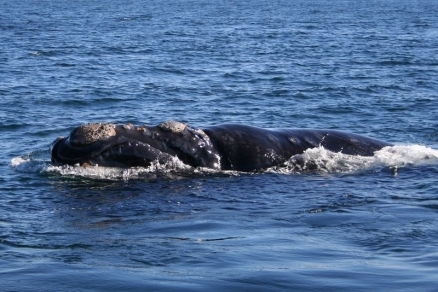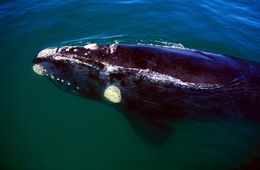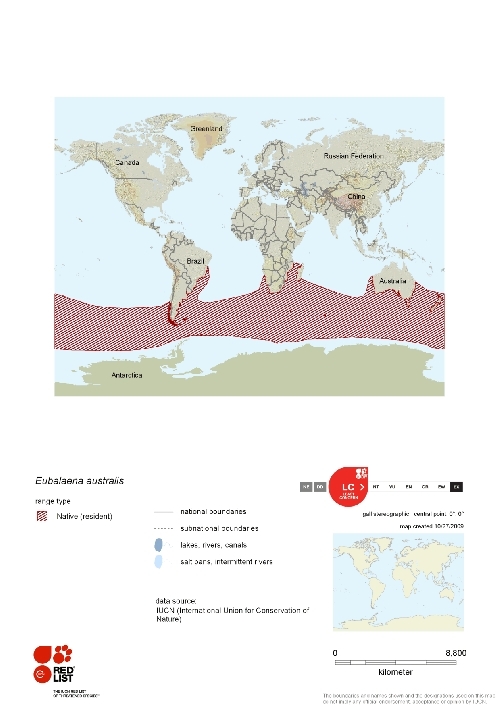Southern right whale
The Southern right whale (scientific name: Eubalaena australis) is one of four species of marine mammal in the family Balaenidae, part of the order of cetaceans.The Southern right whale is a baleen whale, meaning that instead of teeth, it has long plates which hang in a row (like the teeth of a comb) from its upper jaws. Baleen plates are strong and flexible; they are made of a protein similar to human fingernails. Baleen plates are broad at the base (gumline) and taper into a fringe which forms a curtain or mat inside the whale's mouth. Baleen whales strain huge volumes of ocean water through their baleen plates to capture food: tons of krill, other zooplankton, crustaceans, and small fish.
The right whale got its name because during the height of whaling efforts, this was the 'right' whale to catch, as it is large, slow-moving and floats when dead. Following serious over-exploitation from the 1600s until the 1930s, the southern right whale population became dangerously low. International protection in 1935 allowed a slow increase in population, but illegal whaling continued into the 1960s. Since then, the population has been increasing at the calculated 'maximum rate'. However, whilst this huge and unsustainable threat has largely been eliminated, pressures on the southern right whale still exist. Disturbance from vessels, divers, coastal industrial activity, entanglement in fishing gear and water pollution are all concerns.
This whale is easy to identify as it has a uniformly dark colour with white callosities (outgrowths of hard skin) on and around the head which can even be used to distinguish individuals. The body is rotund and the head is very large, making up one third of the total length. Unusually for baleen whales, the Southern right whale does not have a dorsal fin or a grooved throat. The flippers are short and wide, and the blow hole is V-shaped.
Southern right whales belong in separate breeding groups which travel to their own areas to reproduce. Up to eight males may mate with one female between July and August, but unusually for mammals, aggression between males is minimal. Females calve once every three years between June and August, with a gestation period of 11 to 12 months. Calving females go for four months during the winter months without eating, and give birth to a single, large calf weighing up to 1,500 kilograms. Females will nurture and feed their calves in the shallows where they are well protected from attacks by orcas and great white sharks (5). Calves are weaned after a year, and will reach sexual maturity at nine to ten years. These enormous animals eat some of the smallest creatures in the ocean, filtering water through long and numerous baleen plates to feed on the small plankton including larval crustaceans and copepods. Southern right whales produce short, low-frequency moans, groans, belches and pulses. Typical feeding dives last between 10 and 20 metres and southern right whales are also frequently seen at or above the surface of the water, slapping the water with its tail and flippers, rolling, and breaching (launching out of the water and landing on the side or back). The function of these behaviours is not known.
Contents
Physical Description
Southern right whales are characterized by their uniformly dark color and white callosities found on and around the head. Callosities, which are outgrowths of tough skin, are often used in identifying individual whales, as they are unique to each animal, similar to fingerprints in humans. The largest of these excrescences (callosities) is located on the anterior-most portion of the head and is referred to as the "bonnet." Other excrescences are on the upper edge of the lower jaw, behind the blowhole, and above the eye.
Eubalaena australis is on average between 16 and 18 meters long at maturity, males being slightly shorter than females. It has a rotund appearance, a very large girth relative to the length, with an enormous head (approximately 1/3 the body length). Southern right whales do not have any dorsal fins, nor do they have the grooved throat that is typical of the balaenopterids. The flippers are also broad and relatively short.
Another distinguishing physical feature of southern right whales is the blowhole. The exterior of the blow hole is well-partitioned, resulting in a V-shaped exhaust of condensation and water vapor. Furthermore, uncharacteristic of balaenopterids, southern right whales have a well-developed dermis without fat, whereas most balaenopterids lack a dermis (Cummings 1985).
Taxonomy
Northern Pacific right whales were only recently recognized as a distinct species based on genetic evidence so much of the data on their natural history refers to the previously recognized single species, Eubalaena glacialis.
What was long treated as a single right whale species is now recognized as three distinct species by both scientists and federal regulatory agencies. They are:
- North Atlantic right whale (Eubalaena glacialis) which inhabits the Atlantic Ocean, especially between 20o and 60o N latitude.
- North Pacific right whale (Eubalaena japonica), which inhabits the Pacific Ocean, especially between 20o and 60o N latitude.
- Southern right whale (Eubalaena australis) occurring in the southern hemisphere between around 20o and 60o S latitude.
The Bowhead Whale is also a member of the family Balaenidae.
Behavior
Southern right whales migrate to the southern latitudes of their range during the summer months where plankton populations are more abundant, and migrate north during winter and spring.
They do so at a rate of 2.7 to 4.2 kilometers/hour over a 24-hour period for cow and calf pairs. In addition, Eubalaena australis have been observed at near-shore swimming speeds in excess of 15 km/hr (for only short distances), but are generally slow swimmers.
In a common behavior among these whales, called "headstanding", they assume a vertical position and extend the flukes into the air, often rocking back and forth, for as long as two minutes at a time. Research initially indicated that this position was used for feeding on benthic organisms, however is more recently believed to be either a resting position or a courtship stimulus. Southern right whales are also commonly seen breeching -- turning in midair and falling into the water with the side or back of the body. This behavior may dislodge parasites from the whale's surface, but is also a display mechanism during mating (Cummings 1985).
Voice and Sound Production
Eubalaena australis produce short, low frequency moans and pulses. Also heard, often below and above the water's surface, are the blows of the Southern right whales. However, the most common sound produced is a belch-like utterance that averages 1.4 seconds long at a frequency of less than 500 Hertz. These whales also produce simple moans in a narrow range of frequencies and complex moans that shift frequencies and overtones (Cummings 1985). Other sounds created by southern right whales are those caused by the slapping of theirs fins and tails, while rolling over at the surface of the water -- usually occuring during mating courtships.
Reproduction
Southern right whales are polygamous, having up to seven males per one female. Courtship and copulation is described as being tender and graceful (Cummings 1985). The duration of courting bouts varies, but usually lasts for an hour or two, after which the males and females separate from one another. There seems to be no animosity between males mating with the same female, which is quite unusual for mammals. It is believed that this passive behavior implies intra-uterine sperm competition.
Southern right whales reach reproductive maturity at approximately ten years of age. The gestation period ordinarily lasts for one year, and lactation continues for four to six months. Calves, which are born with a body mass of 1000 to 1500 kilograms and are five to six meters long, grow at a rate of around three centimeters per day.
Southern right whales mate and calve between 20 and 30° S and mostly in protected bays during the months of June to November.
Lifespan/Longevity
Maximum species longevity in the wild is estimated to be about 70 years. This species ceases to grow in length or body mass at about age 18 for females and 20 for males.
Distribution and Movements
Found only in the Southern hemisphere, Southern right whales have a circumpolar distribution between 30 and 50 degrees south, inhabiting sub-Antartic waters (Ridgeway 1985).
Habitat
While avoiding warm equatorial regions, Southern right whales remain near continents and island masses.
Food and Feeding Habits
Using their long and numerous baleen plates, Southern right whales feed on small plankton, including pelagic larval crustaceans and copepods. They are most often observed using one of two feeding techniques. The first, surface feeding, occurs when the whales selectively swim through densely-populated plankton slicks with their mouths wide open and baleen exposed. The other method occurs while submerged, presumably in highly dense populations of plankton.
Economic Importance for Humans
Although very rarely found stranded along beaches, southern right whales occasionally do cause harm to themselves and, indirectly, humans. They have collided with large vessels and entangled in fishing gear. This causes a loss or reduction of possible shipping routes (in order to avoid collisions) and an increased cost to the fishing industry.
For the past ten or fifteen years, humans have capitalized on southern right whales, as well as other whales and aquatic mammals. Currently, the increasing popularity of whale watching and coastal tourism has led to the whales having a positive economic impact on humans. The development of whale watching has promoted economic benefits to coastal communities while increasing the protection and awareness of the species - stressing the importance of environmental quality and conservation. This benefit to the whales and their habitat contrasts sharply with previous economic exploitation of southern right whales. They were extensively hunted for oil and meat before becoming protected.
Threats and Conservation Status
Following serious over-exploitation from the 1600s until the 1930s, the Southern right whale population became dangerously low. International protection in 1935 allowed a slow increase, but illegal whaling continued into the 1960s. Since then, the population has been increasing at the calculated 'maximum rate'. However, whilst this huge and unsustainable threat has largely been eliminated, pressures on the southern right whale still exist. Disturbance from vessels, divers, coastal industrial activity, entanglement in fishing gear and pollution are all concerns.
The IUCN reports that:
Following severe historical depletion by commercial whaling, several breeding populations (Argentina/Brazil, South Africa, and Australia) of southern rightwhales (E. australis) have shown evidence of strong recovery, with a doubling time of 10-12 years (Bannister 2001, Best et al. 2001, Cooke et al. 2001). The other breeding populations are still very small, and data are insufficient to determine whether they are recovering. Estimated total population size as of 1997 was 7500 animals (of which 1,600 were mature females, including 547 from Argentina and 659 from South Africa), and the three main populations have continued to increase at a similar rate since then (Best et al. 2005, Cooke et al. 2003, IWC 2007). Illegal Soviet catches (mainly in the 1960s) temporarily inhibited recovery, but overall the population appears to have grown strongly since then).
International protection by the International Whaling Commission and individual country programs to protect whales has produced significant results since the ban on hunting this species. Conservation activities currently include monitoring population numbers and behaviour through the use of photo identification of individuals, assessing the effects of disturbance, and education programs.
Aside from international protection, individual countries are also protecting these whales and improving their ability to survive and reproduce. In Brazil, the Right Whale project has been in effect since 1981. The program's goal is to protect the whales in their breeding grounds off the coast of South Brazil. Program participants monitor and research the current situation, and inform the public about the importance of environmental protection. Since its establishment, the program has, among other beneficial actions, induced the government for the State of Santa Catarina to declare the southern right whales a state natural monument, thereby assuring its full protection. Other countries have also vowed to minimize human impacts on whale populations. This idea has been followed through by reducing direct disturbance and coastal industrial activity, as well as increasing awareness of the hazards of oceanic dumping that may lead to bioaccumulation and possible extinction.
The southern right whale is classified as Lower Risk / Conservation Dependent (LR/cd) on the IUCN Red List 2007. It is listed on Appendix I of CITES and Appendix I of the Convention for the Conservation of Migratory Species. It is also classified as endangered under the Environment Protection and Biodiversity Conservation Act 1999 and protected within Australian waters under the Whale Protection Act 1980.
Further Reading
- Eubalaena australis (Desmoulins, 1822), Encyclopedia of Life, Accessed February 9, 2011
- Reilly, S.B., Bannister, J.L., Best, P.B., Brown, M., Brownell Jr., R.L., Butterworth, D.S., Clapham, P.J., Cooke, J., Donovan, G.P., Urbán, J. & Zerbini, A.N. 2008. Eubalaena australis. In: IUCN 2010. IUCN Red List of Threatened Species. Version 2010.4.
- Smith, J. 2000. "Eubalaena australis" (On-line), Animal Diversity Web. Accessed May 30, 2011
- Marine Themes (November, 2004)
- WWF (June, 2008)
- Southern Right Whale, Hermanus, South Africa.
- Anonymous. 2004. Report on the Australasian workshop on right whales photo-identification and data analysis. Department of Environment and Heritage, Canberra: 21 pp.. Adelaide, South Australia.
- Bannister, J. 2001. Status of southern right whales (Eubalanea australis) off Australia. Journal of Cetacean Research and Management Special Issue 2: 103-110.
- Bannister, J. L., Pastene, L. A. and Burnell, L. A. 1999. First record of movement of a southern right whale (Eubalaena australis) between warm water breeding grounds and the Antarctic Ocean, south of 60 degrees South. Marine Mammal Science 15(4): 1337-1342.
- Best, P. B. 1994. Seasonality of reproduction and the length of gestation in southern right whale Eubalaena australis. Journal of Zoology (London) 232: 175-189.
- Best, P. B., Brandao, A. and Butterworth, D. S. 2001. Demographic parameters of southern right whales off South Africa. Journal of Cetacean Research and Management Special Issue 2: 161-169.
- Best, P. B., Brandão, A. and Butterworth, D. S. 2005. Updated estimates of demographic parameters for southern right whales off South Africa. International Whaling Commission Scientific Committee.
- Best, P. B., Payne, R., Rowntree, V., Palazo, J. T. and do Carmo Both, M. 1993. Long-range movments of South Atlantic right whales Eubalaena australis. Marine Mammal Science 9: 227-234.
- CITES (November, 2004)
- CMS (November, 2004)
- Cooke, J. G., Rowntree, V. J. and Payne, R. 2003. Analysis of intra-annual variation in reproductive success of South Atlantic right whales (Eubalaena australis) from photo-identification of calving females observed off Pen¡nsula Valdes, Argentina, 1971-2000. International Whaling Commission Scientific Committee.
- Cooke, J. G., Rowntree, V. J. and Payne, R. S. 2001. Estimates of demographic parameters for southern right whales (Eubalaena australis) observed off Peninsula Valdes, Argentina. Journal of Cetacean Research and Management 2: 125-132.
- Department of the Environment and Heritage: Australian Government, Southern Right Whale Recovery Plan
- Department of the Environment and Heritage: Australian Government (June, 2008)
- Gaines, C. A., Hare M. P., Beck S. E., & Rosenbaum H. C. (2005). Nuclear markers confirm taxonomic status and relationships among highly endangered and closely related right whale species. Proceedings of the Royal Society B-Biological Sciences. 272, 533-542.
- Gordon, D. (Ed.) (2009). New Zealand Inventory of Biodiversity. Volume One: Kingdom Animalia. 584 pp
- Groch, K. R., Fabian, M. E., Adler, F. R., Palazzo Jr., J. T. and Flores, P. A. C. 2004. Recent rapid increases in the Brazilian right whale population. International Whaling Commission Scientific Committee.
- IUCN (2008) Cetacean update of the 2008 IUCN Red List of Threatened Species.
- International Whaling Commission. 2001. Report of the workshop on the comprehensive assessment of right whales: a worldwide comparison. Journal of Cetcaean Research and Management 2: 1-60.
- International Whaling Commission. 2004. Classification of the order Cetacea. Journal of Cetcaean Research and Management 6(1): xi-xii.
- International Whaling Commission. 2007. Report of the subcommittee on bowhead, right and gray whales. Journal of Cetcaean Research and Management 9.
- Jefferson, T.A., S. Leatherwood and M.A. Webber. 1993. Marine mammals of the world. FAO Species Identification Guide. Rome. 312 p.
- Kenney, R.D. (2002) North Atlantic, North Pacific, and Southern Right Whales. In: Perrin, W.F., Würsig, B. and Thewissen, J.G.M. Eds. Encyclopedia of Marine Mammals. Academic Press, London.
- Leaper, R., Cooke, J. G., Trathan, P., Reid, K., Rowntree, V. and Payne, R. 2006. Global climate drives southern right whale (Eubalaena australis) population dynamics. Biology Letters 2: 289-292.
- Mead, James G., and Robert L. Brownell, Jr. / Wilson, Don E., and DeeAnn M. Reeder, eds. 2005. Order Cetacea. Mammal Species of the World: A Taxonomic and Geographic Reference, 3rd ed., vol. 1. 723-743
- Ronald Nowak (1999) Walker's Mammals of the World. Johns Hopkins University Press: Baltimore.
- Ohsumi, S. and Kasamatsu, F. 1986. Recent off-shore distribution of the southern right whale in summer. Reports of the International Whaling Commission Special Issue 10: 177-186.
- Perrin, W. (2011). Eubalaena australis (Desmoulins, 1822). In: Perrin, W.F. World Cetacea Database. Accessed through: Perrin, W.F. World Cetacea Database on 2011-02-05
- Rice, D. W. 1998. Marine mammals of the world: systematics and distribution. Society for Marine Mammalogy.
- Ridgeway, S., R. Harrison. 1985. Handbook of Marine Mammals, Volume 3. San Diego, CA: Academic Press Limited.
- Rosenbaum, H. C., Brownell Jr., R. L., Brown, M. W., Scaeff, S. C., Portway, V., White, B. N., Malik, S. and Pastene, L. A. 2000. World-wide genetic differentiation of Eubalaena: Questioning the number of right whale species. Molecular Ecology 9: 1793-1802.
- Rosenbaum, H. C., Razafindrakoto, Y., Vahoavy, J. and Pomilla, C. 2001. A note on recent sightings of southern right whales (Eubalaena australis) along the east coast of Madagascar. Journal of Cetacean Research and Management 2: 177-179.
- Rowntree, V. J., Mcguinness, P., Marshall, K., Payne, R., Sironi, M. and Seger, J. 1998. Increase harassment of right whales (Eubalaena australis) by kelp gulls (Larus dominicanus) at Peninsula Valdez, Argentina. Marine Mammal Science 14(1): 99-115.
- Rowntree, V. J., Payne, R. S. and Schell, D. S. 2001. Changing patterns of habitat use by southern right whales (Eubalaena australis) on their nursery ground at Peninsula Valdes, Argentina, and in their long-range movements. Journal of Cetacean Research and Management 2: 133-144.
- Taylor, B. L., Chivers, S. J., Larese, J. and Perrin, W. F. 2007. Generation length and percent mature estimates for IUCN assessments of Cetaceans. Southwest Fisheries Science Center.
- Tormosov, D. D., Mikhaliev, Y. A., Best, P. B., Zemsky, V. A., Sekiguchi, K. and Brownell Jr., R. L. 1998. Soviet catches of Southern Right Whales Eubalaena australis, 1951–1971. Biological data and conservation implications. Biological Conservation 86: 185–197.
- UNESCO-IOC Register of Marine Organisms
- Wilson, Don E., and DeeAnn M. Reeder, eds. 1993. Mammal Species of the World: A Taxonomic and Geographic Reference, 2nd ed., 3rd printing. xviii + 1207
- Wilson, Don E., and F. Russell Cole. 2000. Common Names of Mammals of the World. xiv + 204




